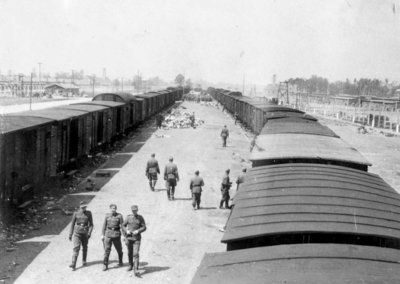bombsaway wrote:The grave descriptions I quoted here
viewtopic.php?f=2&t=14859&start=375#p110005 are taken verbatim from Kola's study. As you can see, according to his descriptions, 31/33 graves contained cremains, and the other two graves bodies. Every grave had human remains of some kind. I couldn't find a good scan of the core sample illustrations so can't comment on that. Are you saying that Kola "drummed up" his descriptions, but not the core sample illustrations, which could have just as easily been fabricated?
I think what happened is either you or Mattogno are conflating "human remains" with cremains, while Kola was just talking about uncremated bodies.
On the same page, I explained why the descriptions indicated substantial amounts of cremains.
However many "cremains" you claim to find, bombsaway, there should be
far more wood ash than human ash.
At Belzec, for the presumed number of 434,508 corpses, we should expect at minimum the following produced as a result (from Mattogno/Graf/Kues, TECOAR, p. 1313-1316):
22,537 m³ wood ash & non-combustible volume
3,215 m³ human ash & non-combustible volume
In other words, mass open-air cremation at Belzec results with the following:
85.7% of ash & non-combustible volume is wood-based
14.3% of ash & non-combustible volume is human-based
For every time we observe x amount of "human ashes" at Belzec, therefore, we need to find 6x (six times as much) wood ashes by volume corresponding to the same location.
The problem is, only 18 of 33 pits are noted in the Kola study as apparently containing "charcoal" or "wood ash". This suggests, by necessity, that much of what was deemed "crematory ash" ("cremains") is actually wood ash (or mixed heavily with it).
By weight, the ratio of ash to non-combustibles that results when burning either corpses or wood is approximately 1 to 1.67. I.e. you can calculate the total amount of anticipated fine ash times 167% to get an approximation of the total burn output/product (TECOAR, op cit).
Hence, about 60% (1/1.67) of what results from open-air cremations by mass is pure, fine ash. The rest is non-combustibles (bone fragments, wood charcoal).
...and 6/7ths of that fine ash (85.7%) by volume which results from open-air cremation is, in fact, wood ash.
Hence, for every pit which has a layer or mixture of human ash, there should be a layer or mixture six times as large by volume of wood ash.
And for every pit which has a layer or mixture of human non-combustibles (bone fragments), there should be a layer or mixture six times as large by volume of wood charcoal.
But as mentioned, wood ash and charcoal are only even mentioned for 18 of 33 pits in the Kola study, and never in particularly remarkable quantities by comparison to alleged human ash/remains.
So, what is going on here?
Again, it looks like wood ash is being conflated with human ash quite extensively. Perhaps anytime anything resembling human bone or fragments thereof has been observed in a layer/mixture of wood ash, it has been deemed "crematory ash".
Moreover, in all of this analysis above, we have not even factored in that not just wood and not just Jews were burned at Belzec; Jewish property and other items were burned there as well. So this also needs to be factored into the equation of human versus non-human ash, for which Kola's discernment is seriously drawn into question.
For the 434,508 Jews reportedly killed at Belzec, Mattogno notes that the amount of wood ash that would be produced in open-air cremation there would far exceed the total volume of Kola's pits (op cit). But even if we say just 100,000 Jews were killed there (which would invalidate many important "Holocaust" documents, such as the Hoefle telegram), we still need gigantic pits packed-full of wood ash. Where are they, bombsaway?
Of course, as Archie already notes, these 434,508 Jews were reportedly buried before they were ever turned into cremains. So, we need to find disturbed soil accounting for a grave sufficient to hold this many corpses as well. Where is it?
Are you accepting the Cornides diary as legitimate? It clearly evidences a mass killing operation through numerous second hand statements.
I do not accept this diary (which I've never heard of) as legitimate. You cited it, I showed that even if accepting your cited passage as valid, it's still pure nonsense. Burning corpses don't smell like sweet deliciousness. Burning corpses would seldom even be reported as a mere "burning smell". The smell is horrendous, putrid, absolutely foul, especially when considering the scale of cremation being alleged there. It would overpower any other smell of "sweet" that might be floating nearby.
I note that you said perhaps the lime smelled sweet.

Please purchase some lime, bombsaway, from your nearest Home Depot, and take a
big whiff, then let us know how sweet it smells.
But perhaps it smells sweeter when poured over a large pile of rotting corpses?
Absolutely nowhere does Browning say Eichmann made up gas chamber stories, that's a revisionist invention. Rather he thinks Eichmann was talking about an experimental gassing site near Majdanek (which would explain confusion about the name)
Browning says Eichmann's pretrial credibility is brought into question, here. That's the point. The claim that "he was probably referring to a different gas chamber!" is nonsense. The fact is: Eichmann said he was at Majdanek and saw Jews getting gassed, and this never actually happened. He lied. It's one of many lies he would be caught in, on-the-record, in many years to come.






